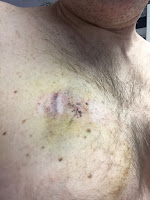Also, please make sure you leave your name or sign-in somewhere in your comment. Thanks.
Writer’s Note – I’ve been on an extended hiatus for well over nine months. So, I first want to say “Thank You” to all of you who continue to stop by and check out my blog. This blog and several to follow have been accumulating in my head for quite a while.
November 12, 2015 – I came out of the “fog,” again, and tasted the dry spittle in my mouth. Vicki said hi and how are you feeling. I vaguely remember saying that I didn’t feel as bad as the last time. This was my second ablation procedure in three months. The purpose of these procedures – think out-patient surgeries – was to remove the two large tumors from both my right and left lungs. I described ablation in my March 2015 post Decisions, Decisions, Decisions:
Ablation essentially means to vaporize or burn something. In my case, a cancerous tumor. There are three key types of ablation treatments: radiofrequency, microwave, and laser. According to the Mayo Clinic’s website, radiofrequency ablation for cancer is a minimally invasive procedure that uses electrical energy and heat to destroy cancer cells. Basically, they would stick a needle in my lung and “zap” the tumor with heat.
###
In early September, I had the tumor in my left lung ablated. It was in the middle to lower half of the lung and required the doctor to go in through my back. Unfortunately, you are awake for the first part of the procedure in which a needle is inserted into the tumor site while your strapped down in a CT scanner. It’s a cumbersome process for the surgeon who has to align and re-align his “mark” using the CT images. All the while, you – the patient – are required to be still and breathe normally. Similar to having dental work done, you are stuck several times with deadening medicine, which hurts worse than the procedure. Think of being jabbed with a sharp needle INSIDE your body. It’s an absolutely weird (and painful) sensation.
Once the surgeon “marks” the tumor, the ablation process begins. Fortunately, you – the patient – are given muscle relaxants, then put to sleep. Apparently, while “out” your breathing stays in a normal rhythm, which allows the doctor to finish burning the tumor. Since I was lying on my side for the September procedure, I didn’t see what was going on during the time I was awake. I could feel it, and that was bad enough.
The November procedure, however, was a whole nother level of pain. First, I had to be injected several times with a local anesthetic. Several times! In my chest! If you want to understand what it feels like, take a straight pin and prick yourself in the forearm. Now imagine driving that needle through your forearm and stopping about halfway. That’s about the only way to comprehend what happened just to deaden the procedure area. Second, the tumor in my right lung is in the far upper half of the lung AND it’s close to the outer lining of that lung. The surgeon warned me that being close to the lining was going to make it tricky and, potentially, harder to ablate. That meant I had to be calm and breathe rhythmically.
 |
| Post op bruising. Ouch!
|
Finally, the location of this tumor dictated that I would be on my back – essentially lying down, face up – with a court-side view of the entire pre-ablation process. While I have now gotten used to having blood drawn, surgical procedures, scans, etc., I still don’t do well with actually seeing what is happening to me. At some point I looked down over my chin to see a seven- or eight-inch needle sticking out of my right chest. I was trying to control my breathing and I coughed, which made the needle jiggle. Yuck! That’s just so gross.
The procedure ended – it only takes about 45 minutes – and I was back in my little recuperation area. It would be another couple of hours before I could go home. The doctors wanted to make sure my right lung had not collapsed or that there was any internal bleeding. It will be several months before the scars heal and the scans will show whether or not these procedures were successful. Let’s hope they are…I’m not sure I want to be a pin cushion, again.
Thanks for listening.

0 Comments